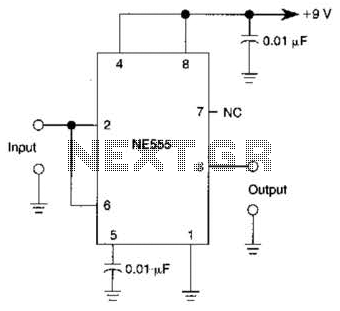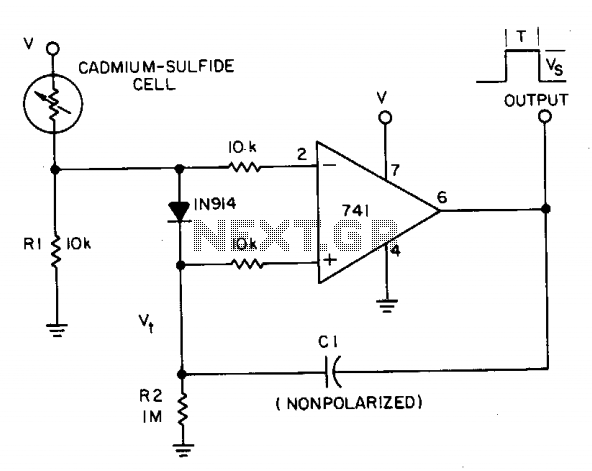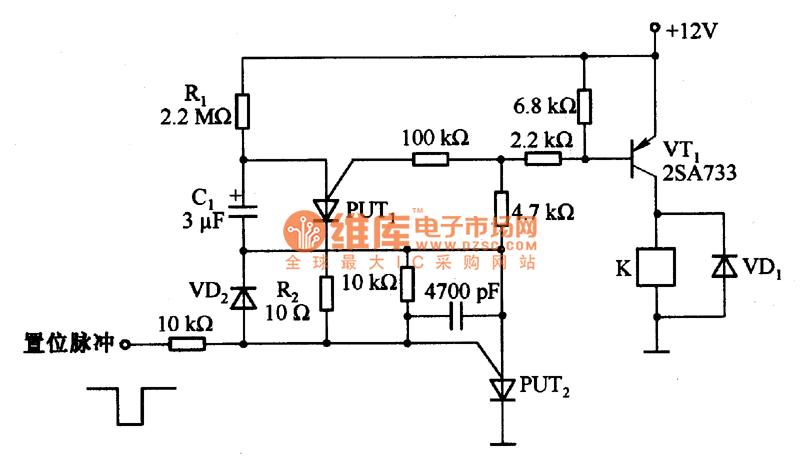
Simple Schmitt Trigger Circuit

A 555 IC is configured to function as a Schmitt trigger. Inputs above and below the threshold level will turn the circuit on and off, producing a square wave output.
The 555 timer integrated circuit (IC) is a versatile device commonly used in various applications, including oscillators, timers, and pulse generators. When configured as a Schmitt trigger, the 555 IC utilizes its internal comparators to provide hysteresis, allowing for clean switching between high and low output states in response to varying input signals.
In this configuration, the 555 timer operates in astable mode, where it continuously switches between its high and low states, generating a square wave output. The circuit includes two threshold levels: the upper threshold (2/3 Vcc) and the lower threshold (1/3 Vcc), which determine the switching points of the output. When the input voltage exceeds the upper threshold, the output switches to a low state, and when it falls below the lower threshold, the output returns to a high state. This hysteresis effect reduces the likelihood of false triggering caused by noise or fluctuations in the input signal.
The timing components, typically resistors and capacitors, are crucial in defining the frequency and duty cycle of the output waveform. The relationship between these components can be calculated using standard formulas, allowing for precise control over the output characteristics. The output of the 555 Schmitt trigger can be used to drive various loads, such as LEDs, transistors, or other digital circuits, making it an essential building block in electronic design.
Overall, the 555 IC configured as a Schmitt trigger is an effective solution for applications requiring reliable signal conditioning and waveform generation. A 555 IC is shown configured to function as a Schmitt trigger. Inputs above and below the threshold level will turn the circuit on and off producing a square wave output.
The 555 timer integrated circuit (IC) is a versatile device commonly used in various applications, including oscillators, timers, and pulse generators. When configured as a Schmitt trigger, the 555 IC utilizes its internal comparators to provide hysteresis, allowing for clean switching between high and low output states in response to varying input signals.
In this configuration, the 555 timer operates in astable mode, where it continuously switches between its high and low states, generating a square wave output. The circuit includes two threshold levels: the upper threshold (2/3 Vcc) and the lower threshold (1/3 Vcc), which determine the switching points of the output. When the input voltage exceeds the upper threshold, the output switches to a low state, and when it falls below the lower threshold, the output returns to a high state. This hysteresis effect reduces the likelihood of false triggering caused by noise or fluctuations in the input signal.
The timing components, typically resistors and capacitors, are crucial in defining the frequency and duty cycle of the output waveform. The relationship between these components can be calculated using standard formulas, allowing for precise control over the output characteristics. The output of the 555 Schmitt trigger can be used to drive various loads, such as LEDs, transistors, or other digital circuits, making it an essential building block in electronic design.
Overall, the 555 IC configured as a Schmitt trigger is an effective solution for applications requiring reliable signal conditioning and waveform generation. A 555 IC is shown configured to function as a Schmitt trigger. Inputs above and below the threshold level will turn the circuit on and off producing a square wave output.





